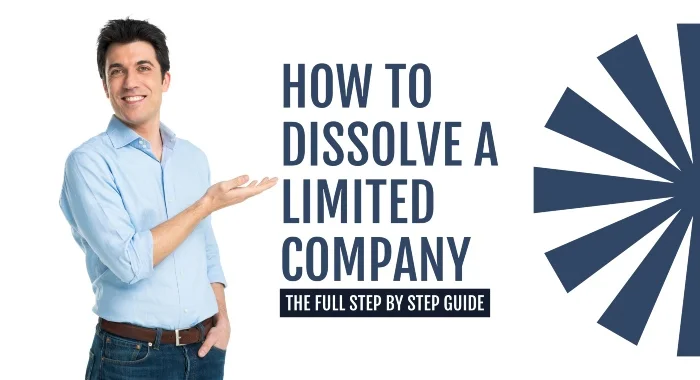We’d love to always focus on the happy and inspiring side of starting a new business. But in giving the best, practical advice, we have to cover what happens when it’s time for a business to end.
In the UK, annual rates of dissolving businesses are 11% – nearly as high as how many new businesses are formed every year (13%).
There are many reasons that a business needs to be dissolved, one of them being the sad truth that it just might not have worked out. Almost 1 in 5 businesses fail in the UK each year, and this time you might have been on the unlucky end of that statistic.
Whatever the reason may be, if it’s time to put an end to your business, we’ve got you covered in this step-by-step guide on how to dissolve a limited company.
Dissolving your limited company is a permanent decision
There are multiple reasons that a limited company should be dissolved, including:
- You want to retire or give up the company, without wanting to sell or pass it on to another director
- You can’t find a suitable buyer for the business
- You want to run the business under a different legal structure, such as a partnership or sole tradership
- You want to move on to a new business or venture
- Your business is no longer profitable or in demand
Whatever the reason, it’s worth pointing out that this isn’t one that you can reverse. Once dissolved, your firm will no longer exist. If you want to move on, but have the company still exist, you might want to consider selling your shares instead.
If you’re not 100% sure about the decision, you can always register your firm as dormant and stop trading until you make the final call.
Solvent and insolvent limited companies are dissolved differently
How you dissolve your limited company depends on whether your business is solvent or insolvent.
- Solvent companies are businesses that can pay their bills.
- Insolvent companies are businesses that currently can’t pay their bills.
If your company is solvent: You can choose to dissolve it voluntarily. This process involves filing specific forms with Companies House and ensuring that all debts and taxes are paid.
If your company is insolvent: You may need to consider alternative options, such as administration or liquidation. These procedures are more complex and involve the involvement of insolvency practitioners. Whichever path you take, we’ll guide you through the step-by-step process. If you’re unsure about your company’s financial status or the best course of action, it’s advisable to seek professional advice from an accountant or insolvency specialist.
How to dissolve a solvent limited company

If your business is solvent and can currently pay its bills, this is your step-by-step guide to dissolve your company.
Download our free checklist to ensure you don’t miss any crucial steps and to streamline the dissolution process.
For a solvent firm, you can voluntarily strike off your company from the register or start a member’s voluntary liquidation (MVL).
Typically speaking, getting your business voluntarily struck off the register is the cheapest and easiest option to go for, as it only involves filling out a form and taking any retained profits as a dividend.
All profits that you make will be subject to capital gains tax (CGT), which is 10% for basic rate taxpayers and 20% for those on a higher band. The profit may also be subject to income tax – which could make the whole thing quite costly.
On the other hand, an MVL may be a better value option from a tax perspective if your profits are higher. This is when a company is closed down, with all remaining assets distributed to shareholders as cash.
These profits are only subject to capital gain tax, which could be lowered to 10% if you qualify for an entrepreneur’s relief.
If you choose to do an MVL, you must appoint and pay for a licensed insolvency practitioner to manage the process. This process can also take up to 12 months to complete, so if you need the profits sooner rather than later, you might want to consider a voluntary strike-off instead.
Your Free Downloadable Checklist To Dissolve A Solvent Limited Company
- Use this checklist to dissolve your solvent limited company
- Don’t miss a step
- Get peace of mind that everything is covered
Voluntarily striking off your company
Step 1: Stop trading
Before you can apply for a voluntary strike off your company, you need to be inactive for at least 3 months. That means you need to have fully stopped trading and only complete activities such as settling debts or disposing of assets.
You must pay close attention to what’s needed here, as any profits left in your company as soon as you submit the DS01 form will legally belong to the crown, and you won’t be able to get them back.
Basically, these three months give you plenty of time to wrap up shop and take away any remaining profits from your firm before the official notice goes up that you’re no longer in business.
To help you out, here are the 10 steps of the important admin tasks that you must complete.
- If you have any employees, you must either make them redundant or ensure that their final wage has been paid. If you need more advice on making staff redundant, we’d recommend getting legal advice to ensure you follow the correct protocol.
- You’ll also need to close payroll.
- Complete any outstanding work and any due fees – making sure you don’t accept any new contracts. This is just to complete anything you have outstanding.
- Sell any company assets and distribute the profits among your shareholders as dividends.
- Make sure any utility bills and contracts are ended and paid up.
- Transfer website domains and ensure that any online order systems are taken down.
- Prepare final company accounts and tax returns and send them to HMRC and Companies House. During this, you must also send a letter signed by the directors, informing them that you wish to close the firm.
- Ensure that any due tax, including VAT, Corporation Tax, PAYE, or NI is paid.
- Deregister your company for VAT, if you are registered.
- Close all your company bank accounts.
It might seem like a lot, but this stage is all about shutting up shop and making sure that everything is paid up and emptied. Think of it like moving house – you need to move out all your belongings, shut off your utilities and make sure that all your information is accurate.
Once done and three months of no trading have passed, you can then complete the final step: submitting your DS01 form.
Did you know… You can save yourself the hassle of preparing and submitting the legal paperwork by using a company dissolution service like 1st Formations.
Step 2: Submit your DS01 form

Now it’s time for the official closing down step for your company, by completing a DS01 form to Companies House. This form is a quick one to complete, only requiring:
- Company registration number
- Company name
- Signatures of the company’s officers authorising the Strike-Off
This form does come with a small fee, costing £44 to complete, or £33 when submitted directly on the Companies House website. When paying this fee, make sure that you pay it out of your own personal bank account, as using a company’s bank account still technically counts as trading.
Once submitted, Companies House will get the information, send a postal confirmation and publish a notice in the London, Edinburgh, or Belfast Gazette (depending on where your business is based). If no one objects to the strike-off after three months, your firm will be officially dissolved.
Step 3: Keep all your records
After you have dissolved your limited company, you need to keep all business documents for a minimum of seven years, and employee records for 40 years. This includes your employer’s liability schedule and policy.
For best practice, we’d recommend keeping all records on file in case you ever need them.
Recommended – Top-Rated Online Accountant:
Start a member’s voluntary liquidation (MVL)
If you choose to start an MVL instead of voluntarily striking off your business, the process is a little different and is mostly dealt with by your liquidator.
Step 1: Assign an Insolvency Practitioner
The MVL process starts with assigning an Insolvency Practioner to look at dissolving your company.
Not sure where to look? You can use the Gov.uk website to search for a licensed insolvency practitioner in your area.
Your practitioner will then provide an information request list to your directors, shareholders and company accountants.
This will ask for information such as HMRC references, Details of assets and liabilities, Bank details and Identification documents to get a more detailed view of your company.
Step 2: Declaration of Solvency
Once your Insolvency Practioner has all your information, you can prepare a Declaration of Solvency. This document is an up-to-date statement of assets and liabilities, with a promise that the company can and will pay its debts and interest within 12 months of liquidation.
It must be signed by all (or the majority) of directors in the presence of a solicitor.
Step 3: Appoint a liquidator and wind up the company
After the declaration of solvency is declared, the shareholders need to meet to pass all necessary resolutions and appoint someone as a Liquidator.
The Liquidator will:
- Advertise in the London Gazette, inviting creditors to submit claims within 21 days.
- Review and address any received creditor claims.
- Sell the company’s assets to generate funds for debt repayment.
- Complete all necessary paperwork to wind up the company’s affairs.
Once complete, the Liquidator will also remove the company from the official register.
Step 4: Keep all records on file
No matter which dissolution option you use, you must keep all your company records on file in case they’re needed.
Your business records should be kept for at least seven years, and employee records for 40 years. This includes your employer’s liability information.

How to dissolve an insolvent limited company
If your business is insolvent, (i.e. can’t pay its bills), the dissolving process works a little differently than a solvent company.
Choose your dissolving option
For an insolvent company, you need to take one of the following actions to dissolve your firm:
- Put your company into administration
- Arrange creditors’ voluntary liquidation (CVL)
Going into administration protects your firm from any legal action by those who are owed money (your creditors) and stops anybody from applying to wind up your company using the process.
During this, you will appoint an administrator, (who must be a professional ‘insolvency practitioner’) that will get full control of your business and its assets. Then, within the next 8 weeks, your administrator must write a statement explaining what they plan to do with the company, including:
- Negotiate a Company Voluntary Arrangement (CVA) to pay creditors over a fixed period, so your business can keep trading
- Sell your business as a ‘going concern’ to another company
- Sell your assets as part of a creditors’ voluntary liquidation and pay your creditors from any money raised and close your company
If there’s nothing to sell, an administrator can also choose to close your firm.
A Creditors Voluntary Liquidation (CVL) is similar to a member’s voluntary liquidation (MVL), where all remaining assets are turned into cash values. However, this time, all the money is used to repay creditors on a pro-rata basis.
To perform this action, you need to have a vote at a shareholders’ meeting, where at least 75% must vote for the CVL. If it passes, you can appoint your insolvency practitioner and begin the process.
If it doesn’t pass the vote, your creditors may be able to force you into a compulsory liquidation to recover their money.
Get the best help dissolving your limited company
Dissolving a limited company can get confusing pretty quickly with the number of options and steps that you must take. Our golden piece of advice is that you must always get a second opinion from your accountant and/or additional legal advice to ensure that you’re taking the best path for your business.
To make the process even quicker, you can also use company dissolution services to handle all of the details for you.
We recommend the 1st Formations company dissolution package as it takes care of all the legal paperwork for you, requiring very little input from the firm’s directors.
After paying the one-off fixed fee of £69.99, 1st Formations will send you some paperwork you need to keep, and some paperwork that each director will need to sign (this can be done electronically).
That’s it! Once you’ve done that, everything will be submitted to the Companies House for you (you won’t even have to pay the Companies House filing fee). You’ll receive a confirmation once it’s completed.
You’ll still need to ‘shut up shop’ yourself by closing down your payroll, bank accounts, etc. beforehand – but the legal act of dissolving your firm is taken care of by a team of experts.
Click here to check out the 1st Formations company dissolution service
If you want to do it yourself, download our free checklist to make sure that you follow all the steps and leave no stone unturned.
Your Free Downloadable Checklist To Dissolve A Solvent Limited Company
- Use this checklist to dissolve your solvent limited company
- Don’t miss a step
- Get peace of mind that everything is covered
For any other help or advice, we’re here for you at Business4Beginners.
Top-Rated Online Accountants:
| Accounting Software | Cheapest Package | Value For Money | Our Rating | Review | Official Site |
|---|---|---|---|---|---|
 | £24.50/mo | Excellent | 9.4 | Read Review | Visit Website |
 | £42/mo | Good | 9.3 | Read Review | Visit Website |
 | Variable | Good | 9.1 | Read Review | Visit Website |









